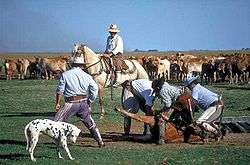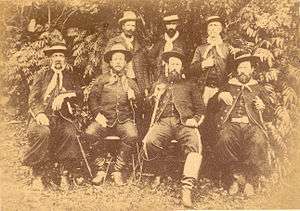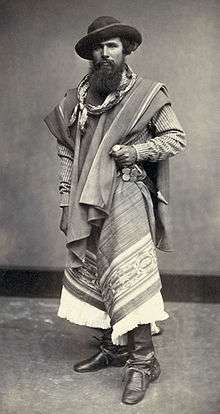Gaucho
| Part of a series on the |
| Culture of Argentina |
|---|
 |
| History |
| People |
| Languages |
|
Traditions |
| Cuisine |
|
Festivals |
| Religion |
|
Music and performing arts |
| Sport |
|
Monuments |
|
Gaucho (Spanish: [ˈɡautʃo]) or gaúcho (Portuguese: [ɡaˈuʃu]) is a word with several meanings. In its historical sense a gaucho was "A mestizo who, in the 18th and 19th centuries, inhabited Argentina, Uruguay and Rio Grande do Sul in Brazil".[1] Today, in Argentina and Uruguay, a gaucho is simply "A country person, experienced in traditional cattle ranching work".[2] Because historical gauchos were reputed to be brave, if unruly, the word is also applied metaphorically to mean "Noble, brave and generous",[3] but also "One who is skilful in subtle tricks, crafty".[4] In Portuguese the word gaúcho (note the accent) means "An inhabitant of the plains of Rio Grande do Sul or the pampas of Argentina descended from European man and [Amer]Indian woman who devotes himself to lassoing and raising cattle and horses".[5]
Gaucho is an equivalent of the North American "cowboy" (vaquero, in Spanish), the Chilean huaso, the Peruvian chalan, the Cuban guajiro, the Puerto Rican jibaro, the Venezuelan or Colombian llanero, the Ecuadorian chagra, the Hawaiian paniolo, and the Mexican charro, which are terms that often connote the 19th century more than the present day; then, gauchos made up the majority of the rural population, herding cattle on the vast estancias, and practicing hunting as their main economic activities.
The gaucho is a national symbol in both Argentina and Uruguay. Gauchos became greatly admired and renowned in legends, folklore and in literature and became an important part of their regional cultural tradition. Beginning late in the 19th century, after the heyday of the gauchos, they were celebrated by South American writers.
Etymology

There are several hypotheses concerning the origin of the term. It may derive from the Spanish term chaucho (in turn derived from Arabic chauia which means herdsman). The first recorded use of the term dates to Argentine independence in 1816. Another scenario indicates the word may derive from the Portuguese gaudério, which was designated to the inhabitants of the vast regions of Rio Grande do Sul and Río de la Plata in the 18th century or the Portuguese garrucho that points to an instrument used by the gauchos to trap and hamstring cattle. The 18th century chronicler Alonso Carrió de la Vandera speaks of "Gauderios" when it mentions the Gauchos or "Huasos" as poorly dressed men.
Culture

The gaucho plays an important symbolic role in the nationalist feelings of this region, especially that of Argentina, Paraguay, and Uruguay. The epic poem Martín Fierro by José Hernández (considered by some[6] the national epic of Argentina) used the gaucho as a symbol against corruption and of Argentine national tradition, pitted against Europeanising tendencies. Martín Fierro, the hero of the poem, is drafted into the Argentine military for a border war, deserts, and becomes an outlaw and fugitive. The image of the free gaucho is often contrasted to the slaves who worked the northern Brazilian lands. Further literary descriptions are found in Ricardo Güiraldes' Don Segundo Sombra. Like the North American cowboys, as discussed in Richard W. Slatta, Cowboys of the Americas, gauchos were generally reputed to be strong, honest, silent types, but proud and capable of violence when provoked. The gaucho tendency to violence over petty matters is also recognized as a typical trait. Gauchos' use of the famous "facón" (large knife generally tucked into the rear of the gaucho sash) is legendary, often associated with considerable bloodletting. Historically, the facón was typically the only eating instrument that a gaucho carried.
Also like the cowboy, as shown in Richard W. Slatta, Cowboys of the Americas, gauchos were and remain proud and great horseriders. Typically, a gaucho's horse constituted most of what he owned in the world. During the wars of the 19th century in the Southern Cone, the cavalries on all sides were composed almost entirely of gauchos. In Argentina, gaucho armies such as that of Martín Miguel de Güemes, slowed Spanish advances. Furthermore, many caudillos relied on gaucho armies to control the Argentine provinces.
The gaucho diet was composed almost entirely of beef while on the range, supplemented by yerba mate (erva mate in Portuguese), an herbal infusian made from the leaves of the yerba tree, a type of holly rich in caffeine and nutrients.
Gauchos[7] dressed quite distinctly from North American cowboys, and used bolas or boleadoras - in Portuguese boleadeiras - (three leather bound rocks tied together with approximately three feet long leather straps) in addition to the familiar "North American" lariat or riata. The typical gaucho outfit would include a poncho (which doubled as a saddle blanket and as sleeping gear), a facón (large knife), a rebenque (leather whip), and loose-fitting trousers called bombachas, belted with a tirador, or a chiripá, a loincloth. During winters, gauchos wore heavy wool ponchos to protect against cold.
Modern influences
Gaúcho is also the common denomination of the current inhabitants of the Brazilian State of Rio Grande do Sul.
Gauchito (a boy in the Argentine colors and a gaucho hat) was the mascot for the 1978 FIFA World Cup.
In popular culture
- Way of a Gaucho 1952 film starring Gene Tierney and Rory Calhoun.
- The Gaucho was a 1927 film starring Douglas Fairbanks.
- La Guerra Gaucha was a 1942 Argentine film set during the Gaucho war against Spanish royalists in Salta, northern Argentina, in 1817. It is considered a classic of Argentine cinema.
- The third segment of Disney's 1942 animated feature package film, Saludos Amigos, is titled "El Gaucho Goofy", where American cowboy Goofy gets taken mysteriously to the Argentine pampas to learn the ways of the native gaucho.
- DC Comics owns two characters named El Gaucho.
- Gaucho is the name of the 1980 album by American jazz fusion band Steely Dan, which featured a song by the same name.
- Gauchos of El Dorado was a 1941 American Western "Three Mesquiteers" B-movie directed by Lester Orlebeck.
Gallery
-

Gaucho in authentic clothing, 1840s.
-

Argentine Pampas gauchos training for the Esgrima Criolla.
-

Un alto en el campo (1861) by Prilidiano Pueyrredon.
-

Chilean gauchos, 1820s.
-

La Posta de San Luis by Juan León Pallière (1858).
-

Two gauchos in Buenos Aires, Argentina, in 1880.
-
.jpg)
Folklore dance: Zamba, Argentina. Gaucho.
-
Emperor Dom Pedro II of Brazil in typical Gaucho outfit.
-

A Chilean gaucho herding sheep.
-

Gauchos in the Corrientes province, Argentina.
-

A Gaucho payador.
-

Brazilian gaucho with typical clothing on 2006 Farroupilha Parade.
-

Argentine gauchos in the city of Salta.
-

Gauchos in the Federalist Revolution (1893 to 1895).
See also
Bibliography
- Assunção, Fernando O. (2006). Historia del gaucho (in Spanish). Claridad. ISBN 978-950-620-205-7.
- Assunção, Fernando O. (1997). Pilchas criollas (in Spanish). Emecé. ISBN 950-04-1121-0.
References
- ↑ Dictionary of the Royal Spanish Academy, Gaucho, sense 5.
- ↑ Dictionary of the Royal Spanish Academy, Gaucho, sense 6.
- ↑ Dictionary of the Royal Spanish Academy, Gaucho, sense 1.
- ↑ Dictionary of the Royal Spanish Academy, Gaucho, sense 4.
- ↑ Dicionário Priberam da Língua Portuguesa, Gaúcho.
- ↑ Leopoldo Lugones 1 in "El Payador" (1916)2 and Ricardo Rojas 3 established the canonical view regarding the Martín Fierro as the National Epic of Argentina. The consequences of these considerations are discussed by Jorge Luis Borges in his essay "El Martín Fierro". An assessment of the years-long discussion here, since p. 18
- ↑ South-images.com Photos: gauchos in Argentina, Photo library South-Images
External links
| Wikimedia Commons has media related to Gauchos. |
- (Spanish) Tierra de Gauchos, Land of gauchos
- (Spanish) Confederacion Gaucha Argentina
- (Spanish) Folklore del Norte Argentino
- (Portuguese) Movimento Tradicionalista Gaúcho
- (Portuguese) Página do Gaúcho
- Aldo Sessas – Gauchos
- Richard W. Slatta – Gauchos and the Vanishing Frontier
- Richard W. Slatta – Cowboys of the Americas
- The Gauchos- Horsemen of the Pampas
- The Gaucho Tradition
- Cowboys in the city - Buenos Aires's gaucho market - video
- site of Gauchos and traditional estancias
| ||||||
|

